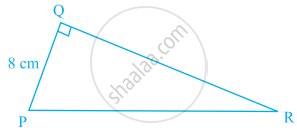Advertisements
Advertisements
प्रश्न
Show that points A (a, b + c), B (b, c + a), C (c, a + b) are collinear.
उत्तर
It is known that the vertices of the triangles A (a, b + c), B (b, c + a) and C (c, a + b)
`Delta` area of `= Delta = 1/2 abs (("x"_1,"y"_1,1),("x"_2,"y"_2,1),("x"_3,"y"_3,1))`
x1 = a,y1 = b + c, x2 = b, y2 = c + a, x3 = c, y3 = a + b
`= 1/2 abs (("a", "b + c", 1),("b", "c + a",1),("c", "a + b", 1)) ...("C"_1 -> "C"_1 + "C"_2)`
`= 1/2 abs (("a + b + c", "b + c", 1),("a + b + c", "c + a", 1),("a + b + c", "a + b", 1))`
`= 1/2 ("a + b + c") abs ((1, "b + c", 1),(1, "c + a", 1),(1, "a + b", 1))`
`= 1/2 ("a + b + c") xx 0 ...("C"_1 "and" "C"_2 "are the same")`
`Delta` area of = 0
Hence, points A, B, C are collinear.
APPEARS IN
संबंधित प्रश्न
Prove that the area of a triangle with vertices (t, t −2), (t + 2, t + 2) and (t + 3, t) is independent of t.
The vertices of ∆ABC = are A (4, 6), B(1, 5) and C(7, 2). A line is drawn to intersect sides AB and AC at D and E respectively such that `\frac{AD}{AB}=\frac{AE}{AC}=\frac{1}{4}` .Calculate the area of ∆ADE and compare it with the area of ∆ABC
The coordinates of A, B, C are (6, 3), (–3, 5) and (4, – 2) respectively and P is any point (x, y). Show that the ratio of the areas of triangle PBC and ABC is
Find the area of the triangle whose vertices are: (–5, –1), (3, –5), (5, 2)
Find the area of the quadrilateral whose vertices, taken in order, are (-4, -2), (-3, -5), (3, -2) and (2, 3).
Find the area of the following triangle:
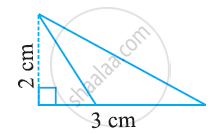
Find the area of a triangle whose vertices are
(6,3), (-3,5) and (4,2)
If `a≠ b ≠ c`, prove that the points (a, a2), (b, b2), (c, c2) can never be collinear.
If the coordinates of the mid-points of the sides of a triangle are (1, 1), (2, —3) and (3, 4), find the vertices of the triangle.
Find the area of a triangle two sides of which are 18 cm and 10 cm and the perimeter is 42cm ?
Show that the points A(-5,6), B(3,0) and C(9,8) are the vertices of an isosceles right-angled triangle. Calculate its area.
If G(-2, 1) is the centroid of a ΔABC and two of its vertices are A(1, -6) and B(-5, 2) , find the third vertex of the triangle.
Find the value of k so that the area of the triangle with vertices A (k+1, 1), B(4, -3) and C(7, -k) is 6 square units
Show that the following points are collinear:
(i) A(2,-2), B(-3, 8) and C(-1, 4)
Show that the following points are collinear:
A(8,1), B(3, -4) and C(2, -5)
Prove that the points A (a,0), B( 0,b) and C (1,1) are collinear, if `( 1/a+1/b) =1`.
Show that ∆ ABC with vertices A (–2, 0), B (0, 2) and C (2, 0) is similar to ∆ DEF with vertices D (–4, 0), F (4, 0) and E (0, 4) ?
Find the value(s) of k so that the quadratic equation x2 − 4kx + k = 0 has equal roots.
Find BC, if the area of the triangle ABC is 36 cm2 and the height AD is 3 cm.
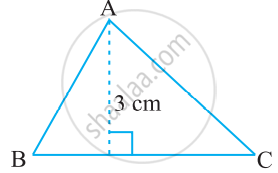
In ∆PQR, PR = 8 cm, QR = 4 cm and PL = 5 cm. 
Find:
(i) the area of the ∆PQR
(ii) QM.
The table given below contains some measures of the right angled triangle. Find the unknown values.
| Base | Height | Area |
| ? | 12 m | 24 sq.m |
Show that the points (a + 5, a – 4), (a – 2, a + 3) and (a, a) do not lie on a straight line for any value of a.
If the points (3, -2), (x, 2), (8, 8) are collinear, then find the value of x.
Let `Delta = abs (("x", "y", "z"),("x"^2, "y"^2, "z"^2),("x"^3, "y"^3, "z"^3)),` then the value of `Delta` is ____________.
The points (0, 5), (0, –9) and (3, 6) are collinear.
Find the area of the triangle whose vertices are (–8, 4), (–6, 6) and (–3, 9).
The base and the corresponding altitude of a parallelogram are 10 cm and 3.5 cm, respectively. The area of the parallelogram is 30 cm2.
The dimensions of a rectangle ABCD are 51 cm × 25 cm. A trapezium PQCD with its parallel sides QC and PD in the ratio 9 : 8, is cut off from the rectangle as shown in the following figure. If the area of the trapezium PQCD is `5/6` th part of the area of the rectangle, find the lengths QC and PD.
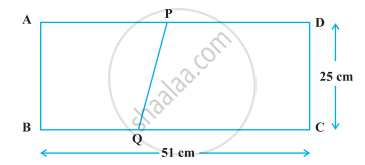
Find the missing value:
| Base | Height | Area of parallelogram |
| ______ | 8.4 cm | 48.72 cm2 |
Ratio of areas of ∆MNO, ∆MOP and ∆MPQ in the given figure is ______.
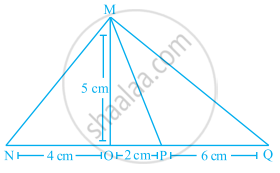
In the given figure, if PR = 12 cm, QR = 6 cm and PL = 8 cm, then QM is ______.

In the given figure, ΔMNO is a right-angled triangle. Its legs are 6 cm and 8 cm long. Length of perpendicular NP on the side MO is ______.
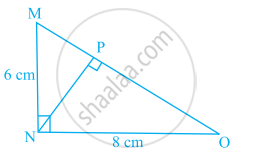
If area of a triangular piece of cardboard is 90 cm2, then the length of altitude corresponding to 20 cm long base is ______ cm.
Area of a triangle = `1/2` base × ______.
Area of a triangle PQR right-angled at Q is 60 cm2 in the figure. If the smallest side is 8 cm long, find the length of the other two sides.
